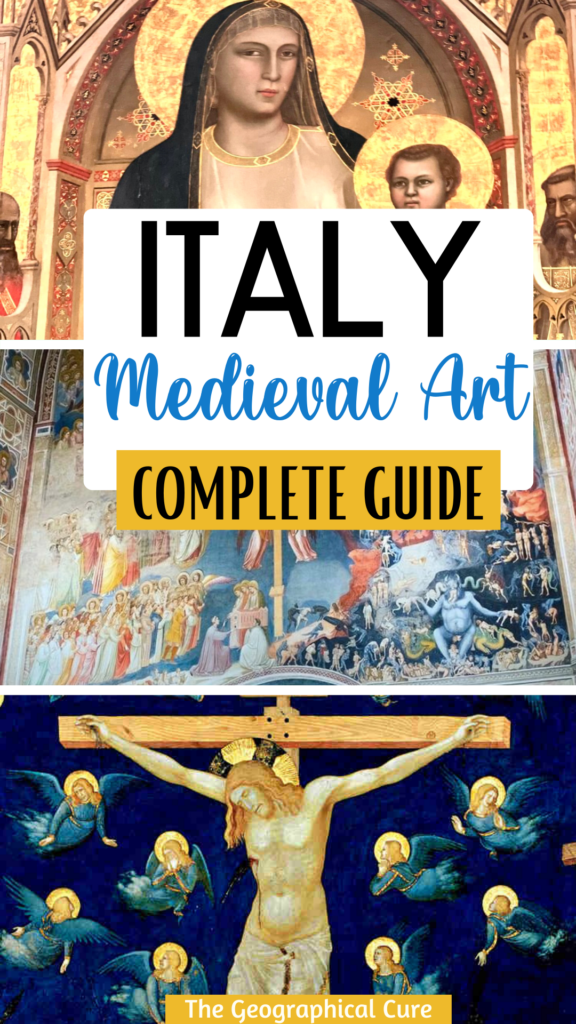Italy is celebrated for its rich artistic heritage, which includes a remarkable cache of rare medieval art. In this article, I give you 20 of the most renowned examples of medieval art that Italy has to offer.
This period in European history spans the fall of the Roman Empire in the 5th century and the dawn of the Renaissance in the 15th century.
Italian art during the Middle Ages was characterized by unparalleled creativity and experimentation. Artists produced works of extraordinary beauty and intricate detail.
What Is Medieval Art?
Medieval paintings in Italy drew on a wide range of artistic traditions, including Byzantine, Romanesque, and Gothic styles.
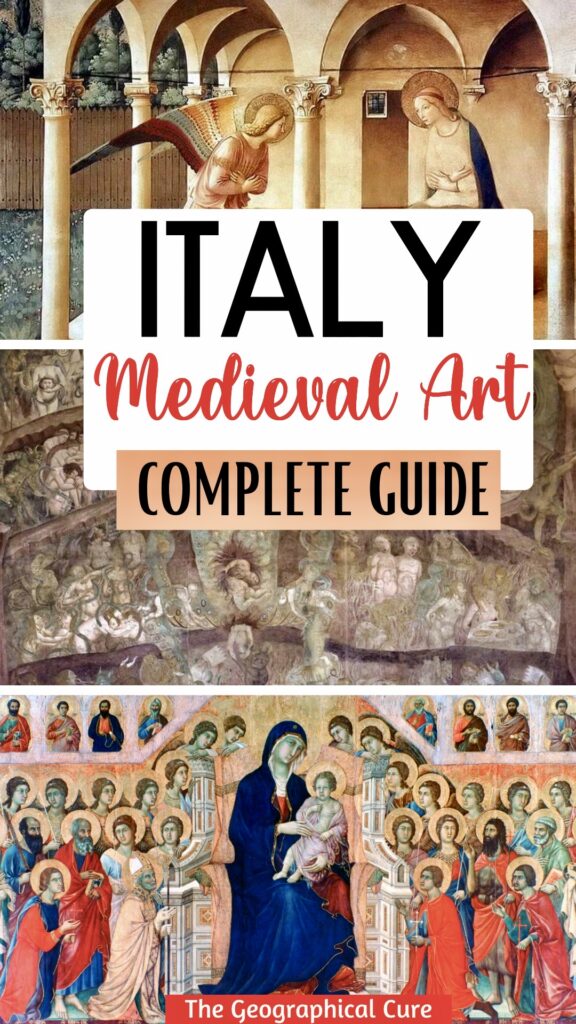
They incorporated elements of courtly literature and romance, such as chivalric ideals and the cult of courtly love. Religious themes were very common too. Madonna con Bambino, or Madonna and Child, was one of the most popular subjects for painters during this time.
As the 15th century progressed, there was a renewed interest in classical art and humanistic themes. International Gothic style gradually gave way to the early Renaissance style.
However, the transition between these two styles was not a clean break, and there was a significant amount of overlap between the two.
Many artists of the early Renaissance I discuss below were heavily influenced by the International Gothic style and continued to incorporate its decorative elements into their work.
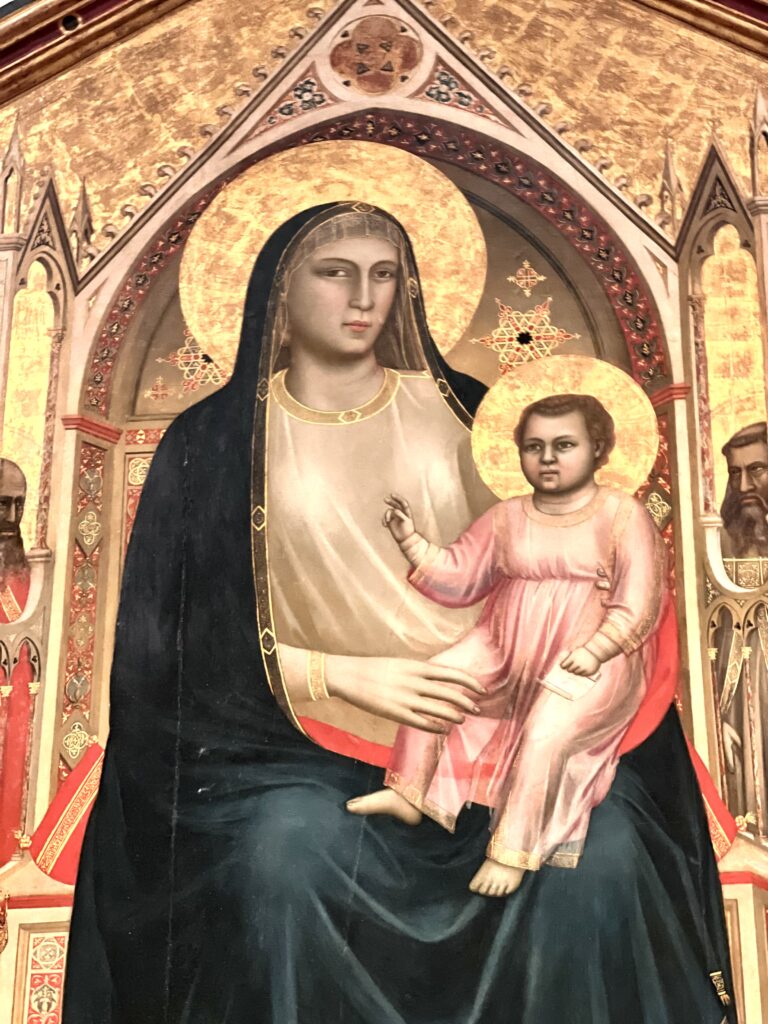
Famous Medieval And International Gothic Style Paintings In Italy
Here’s my list of the 20 best paintings from the Middle Ages in Italy (in no special order).
1. Giotto, Ognissanti Madonna
Giotto is renowned as the first painter who successfully broke away from the Byzantine style of painting, thanks in part to his teacher, Cimabue.
Instead of using an archaic approach, Giotto adopted a more natural style, painting madonnas that didn’t look like unreal aliens. He effectively laid the foundation for two centuries of Renaissance painting to come.
Giotto’s Ognissanti Madonna was named after the Ognissanti Church in Florence, where it used to hang in an altar. What sets this painting apart is Mary’s monumentality and physicality, which is totally different from anything seen in the 13th century.
The painting isn’t flat. Rather, it seems almost sculptural.
Christ is depicted as an old man. This was a fashionable construct at the time to convey his wisdom even as a baby.
The Ognissanti Madonna is now housed in the Uffizi Gallery in Florence and is considered one of Giotto’s most important works.
Where: Uffizi Gallery, Florence
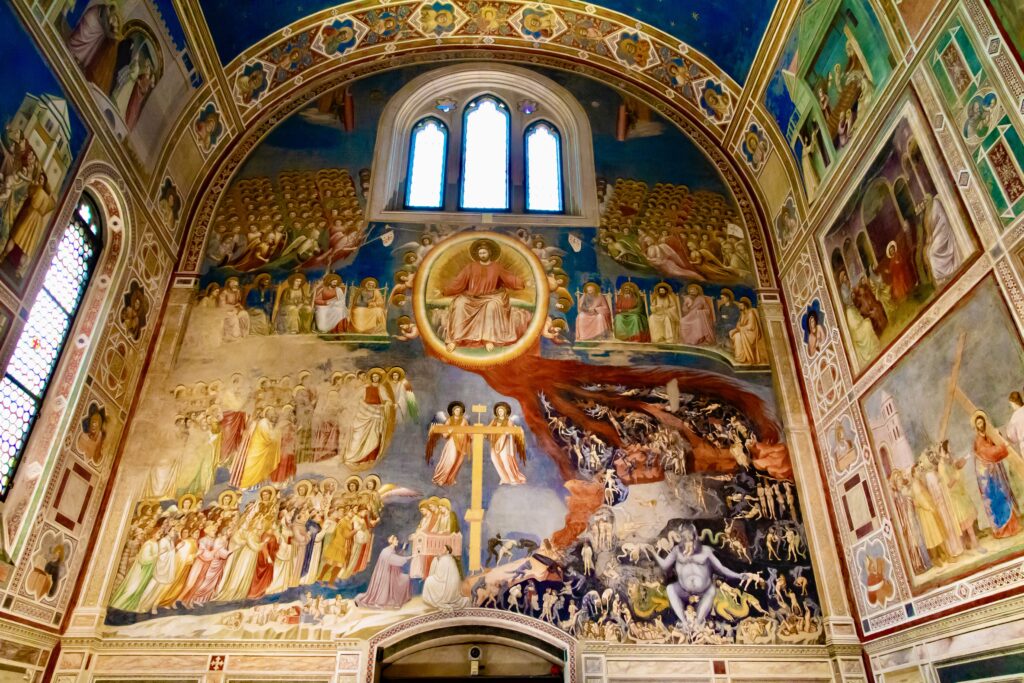
2. Giotto, The Last Judgment
In 1303-05, Giotto painted a stunning cycle of 39 frescos depicting the lives of Mary and Jesus in Padua’s Scrovegni Chapel. The frescos are a precious masterpiece of Italian art. To me, there are three paintings in particular that really stand out.
The Last Judgment fresco captures the apocalyptic moment when the world comes to an end. Jesus presides over the scene. He’s seated in the middle with a radiant full-body halo, deciding the fates of those who stand before him.
Giotto’s painting is a more compassionate interpretation of this religious subject, as he focuses on the saved rather than the damned. Angels escort the saved to heaven while Jesus gives his attention to them.
While Hell in this painting is smaller than the usual depictions, it’s no less brutal, perhaps drawing inspiration from Dante’s Inferno. Sinners are punished in various gruesome ways, including one being roasted alive on a spit, usurers being hung with bags of money, and Judas hanging below them.
Shockingly, even some members of the clergy are depicted in Hell, including a pope. The painting even features nude figures emerging from coffins to face judgement. Two angels at the top of the painting symbolically roll up the sky to signal the end of the world.
Where: Scrovegni Chapel, Padua
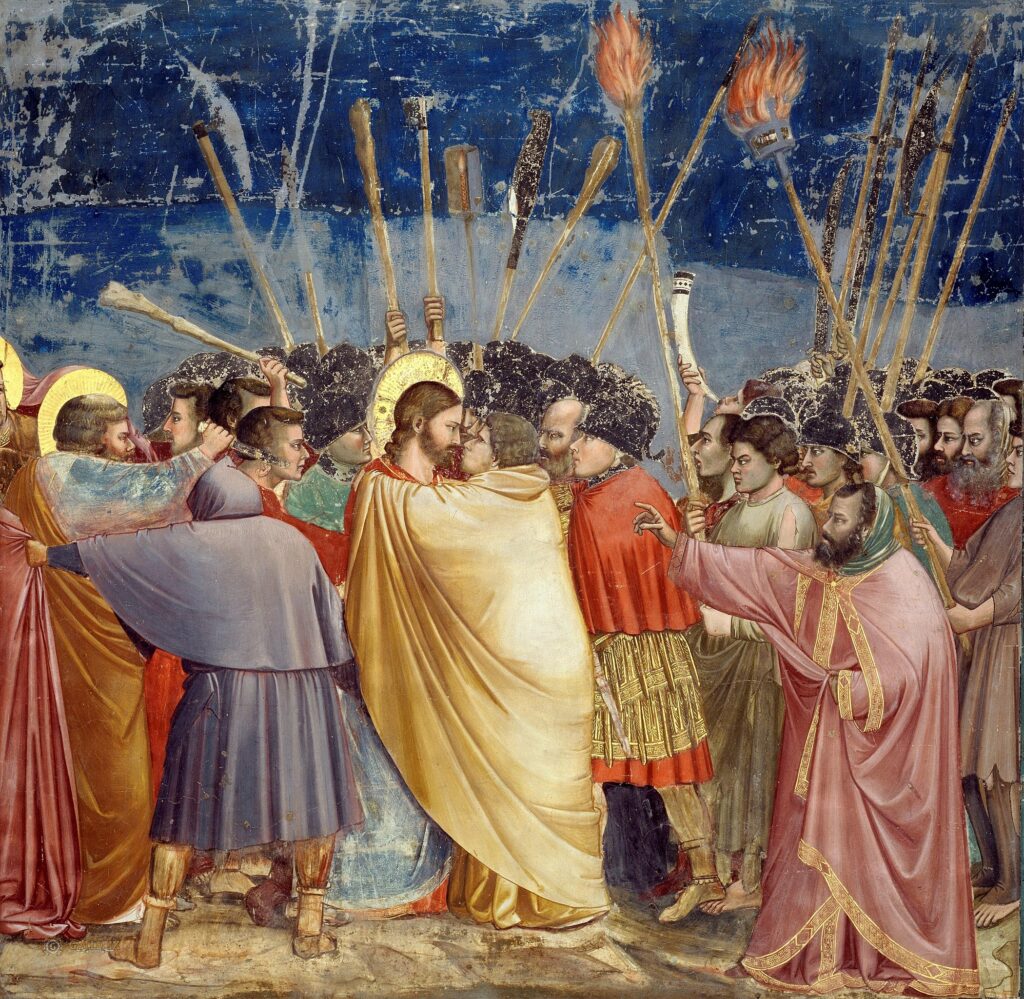
3. Giotto, The Kiss of Judas, Scrovegni Chapel
The Kiss of Judas, alternatively known as The Arrest of Christ, is a captivating and emotive medieval painting in Italy. It immerses the viewer in a full sensory experience, with torches raised and emotions heightened.
In this painting, Judas and soldiers arrive to arrest Jesus. Instead of simply pointing to him, Judas places his yellow-clad arm on Jesus and betrays him with a kiss. Christ is depicted with an air of resigned acceptance, fully aware that he is to be the sacrificial lamb.
The gaze shared between Jesus and Judas is unflinching. The kiss creates a palpable sense of betrayal and treachery. The painting has a godfather-esque quality, as the use of affection to mask betrayal amplifies the horror of the act.
Where: Scrovegni Chapel, Padua
4. Giotto, Lamentation Over a Dead Christ, Scrovegni Chapel
The Lamentation Over a Dead Christ is widely regarded Giotto’s best painting in the Scrovegni Chapel. The powerful scene depicts Christ’s lifeless body being taken down from the cross, with Mary holding her dead son in a tender embrace.
The emotional intensity of the painting is striking. It evokes a range of responses from the viewer, including shock, disbelief, grief, and quiet mourning.
The inclusion of a barren tree serves as a symbol of death and the potential for new life. Giotto simplifies the background and puts the emphasis on the figures. Mary Magdalene tends to his feet with a sense of care.
In a real instance of naturalism, Giotto places two figures with their backs to the viewer, something that had never have been done in painting. It has the effect of bringing the viewer into the painting.
Where: Scrovegni Chapel, Padua
5. Duccio di Buoninsegna, Maesta
The Maesta was created by the Sienese artist Duccio di Buoninsegna. It’s the most famous Italian painting from the International Gothic period and one of the most precious art works ever created in Siena. Today, it is housed in the museum of Siena Cathedral.
The Maesta is a massive double-sided altarpiece, measuring 17 x 16 feet, covered in gold and glitter. It was so large that it likely served as a rood screen for the cathedral, separating the clergy from the common folk.
When Gothic art fell out of fashion during the Renaissance, the altarpiece was taken down and stored for 200 years. Later, the city council disassembled and sold off some pieces, which are now found in some of the world’s most prominent museums. Despite this, most of the Maesta is still in Siena.
The front portion of the Maesta features a majestic Mary seated on a throne, with Jesus swaddled in translucent drapery. In this portrayal, Jesus looks nothing like a baby. Rather, he’s depicted like a wise old man and is almost standing up.
On the back, you can see scenes from the life of Christ, which would have been the view reserved for the priests. The Crucifixion scene is given pride of place in the center and is a striking feature of the painting.
Where: Siena, Siena Cathedral Museum
6. Simone Martini, Maesta
Simone Martini’s Maesta is a painting that marked the day when the Virgin Mary became a central figure in politics. This was the first time that Mary was depicted in a civil setting.
Mary is portrayed as a medieval queen, seated on a throne beneath a regal canopy. She is surrounded by a retinue of saints and angels, serving as the protector of the city.
Baby Jesus is the usual old man. Mary holds a parchment in her hand, bearing the inscription “judge diligently you who rule the earth.”
Sadly, Martini used the fresco secco painting style, which has led to some deterioration of the painting over time. Nevertheless, the beauty and importance of Martini’s Maesta cannot be denied.
Interestingly, Martini’s Maesta bears some similarities to Duccio’s Maesta. Together, these two works serve as a testament to the enduring legacy of the Virgin Mary as a symbol of power and influence in the world.
Where: Siena, Palazzo Pubblico
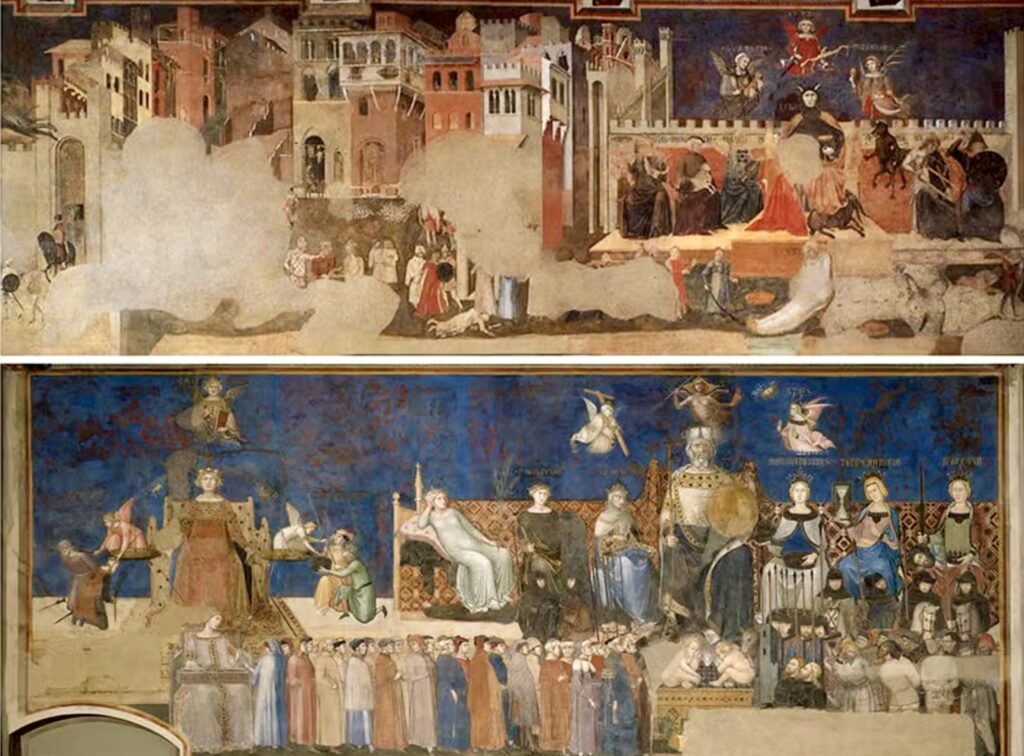
7. Ambrogio Lorenzetti, Allegory of Good and Bad Government, Siena
Ambrogio Lorenzetti’s Allegory of Good and Bad Government is a remarkable and timeless medieval fresco cycle in Italy. It’s a secular painting of everyday urban and rural life from the Middle Ages.
Created between 1337-1341, the didactic paintings portray the key elements of good and bad governance. The cycle is an exceptional representation of the contrast between the peace and prosperity of honest rule and the decay and ruin caused by corrupt tyranny.
The cycle consists of three walls: the Allegory of Good Government, the Effects of a Good Government in the City and County, and the Allegory and Effects of Bad Government. The frescoes are both a promise and a threat, reminding Siena’s Council of Nine how to govern in a moral way.
The Allegory of Good Government portrays Justice and the Common Good, surrounded by the other virtues, while the Effects of a Good Government depict an imaginary Shangri-La with a paradisiacal urban setting and bountiful fields.
In contrast, the Allegory and Effects of Bad Government depict the dramatic and creepy figure of Tyranny and the severe effects of bad governance. In it, you see cities being destroyed, assassinations, criminal acts, and poverty.
Where: Siena, Palazzo Pubblico
8. Fra Angelico, Annunciation
Fra Angelico’s Annunciation is widely considered to be one of the greatest works of Western art. The painting’s large size and captivating presence force viewers to engage with the intimate drama and spiritual reflection portrayed in the artwork.
The painting depicts the moment when the Angel Gabriel tells the Virgin Mary that she will give birth to Christ. Mary is shown in a walled garden with Corinthian columns, evoking the Garden of Eden.
Unlike many other medieval religious artworks in Italy, The Annunciation is not opulent or full of symbolic objects. Mary’s clothes are pale and she appears to be slumped over, as if already experiencing morning sickness.
The only intricate detail is Gabriel’s wings, which are embellished with peacock eyes. The moment of immaculate conception is symbolized by the small grated window with light shining through into the room, representing Mary’s figurative womb.
Where: Florence, San Marco Monastery
9. Barna Da Siena’s Post-Black Death Frescos
The Black Death was a devastating event in medieval Italy, resulting in the death of half the population of many cities and towns. The impact of the Black Death is seen in the art of the time, including a fresco cycle painted by the enigmatic artist Barna Da Siena in 1360.
The haunting cycle depicts 26 scenes from the New Testament, from the Annunciation to the Resurrection. They’re depicted in three tiers across the southern wall of the nave of the Collegiate Church in San Gimignano.
Barna da Siena’s frescos are known for their violence. They’re filled with sinister images, and the scenes of violence are depicted with unparalleled cruelty.
His Massacre of the Innocents is a bloodbath and the Crucifixion is gory. The Betrayal by Judas is perhaps the best piece, evoking a palpable sense of evil. In this scene, Judas’ eyes are fixated on the bag of coins he receives, as they clink into his hands, conveying his greed and betrayal.
Adding to the frescos’ eerie quality, the artist allegedly fell to his death from scaffolding while painting the frescoes.
Where: San Gimignano, Collegiate Church
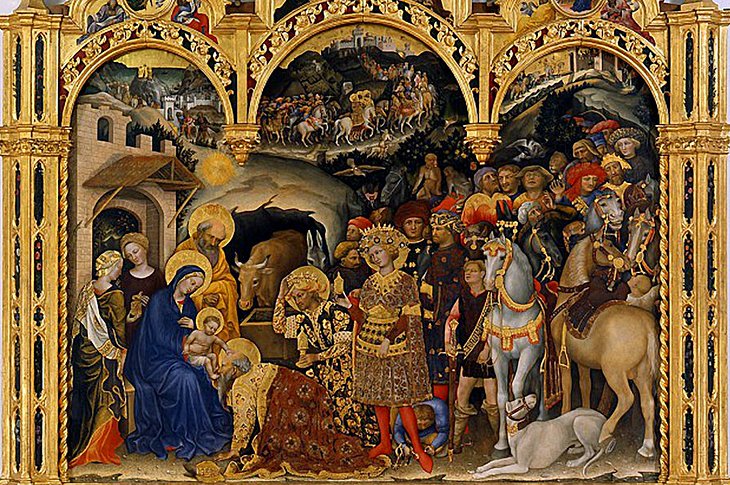
10. Gentile Fabriano, Adoration of the Magi
Gentile da Fabriano was an Italian painter who was active in the early 15th century. He is known for his richly detailed and decorative style, which combined elements of the Gothic and Renaissance periods.
One of his most famous works is the Adoration of the Magi, which is housed in the Uffizi Gallery in Florence. It was created in 1423 for the Strozzi family. It exemplifies the International Gothic style, with its emphasis on ornate decoration, intricate detail, and vivid color.
The painting depicts the biblical scene of the Magi visiting the newborn Jesus, and is filled with intricate details and vibrant colors. The figures are depicted with a high degree of naturalism, and the use of light and shadow adds depth and dimension to the scene.
Where: Florence, Uffizi Gallery
11. Fra Angelico, The Virgin and the Child Enthroned
Another famous medieval painting in Italy is Fra Angelico’s The Virgin and the Child Enthroned. This ancient and delicate painting depicts Mary playing with her child, a popular religious motif of the time.
The painting is a dazzling masterpiece, shining like an exquisite jewel. The Virgin Mary dominates the scene, dressed in three colors – red, blue, and gold.
Meanwhile, the angels form a sort of tapestry around Mary, albeit in more subdued colors. The background of the painting is adorned with flowers.
A striking feature of this artwork is the transparent veil draped over Mary’s head, which showcases the artist’s remarkable attention to detail. The painting also displays a tender moment between Mary and her son, Jesus, which is conveyed through their loving gaze.
Where: Vatican Pinacoteca in Vatican City
12. Giotto, Stefaneschi Polyptych, 1320
The Stefaneschi Polyptych is one of the Vatican’s most ancient works, and the first thing you’ll see when you walk into the Pinacoteca. It’s one of the most important paintings of the 14th century.
The altarpiece is a richly gilded double sided work created by the Florentine painter Giotto, around 1320.
The polyptych originally sat on the high altar of the old St. Peter’s Basilica. When the new St. Peters Basilica was built, the polyptych was moved to the Pinacoteca.
Commissioned by Cardinal Stefaneschi, the piece was created as a triptych, depicting St. Peter on a throne with an array of saints. Cardinal Stefaneschi is at St. Peter’s feet, handing him a miniaturized version of the painting. This likeness is considered among the first realistic portraits ever made.
On the reverse side, in contrast to these stately images, there’s violence. Giotto depicts the crucifixion of St. Peter and the beheading and martyrdom of St. Paul.
Where: Vatican Pinacoteca in the Vatican Museums
13. Crucifix of Cimabue
Cimabue’s Crucifex is one of the great masterpieces in Florence’s Basilica of Santa Croce. Cimabue was a great painter of the 13th century.
Like Giotto, he helped bridge the gap between Italo-Byzantine art and the Renaissance. Cimabue influenced early Renaissance artists like Giotto. Vasari refers to Cimabue as “the first page of Italian art.”
The Crucifix was painted in distemper on wood. It’s an image of a suffering and dying Christ, flanked by saints. The faces are extremely expressive.
The 1966 flood of the Arno River almost completely destroyed the painting, with a loss of 60% of the painted surface. The piece came to symbolize the tragic losses suffered by Florence, and is a reminder of harm from disasters.
In 1976, the Crucifix underwent a massive restoration, which fixed some of the seemingly irreparable damage.
Where: Florence, Basilica of Sant Croce Florence Museum
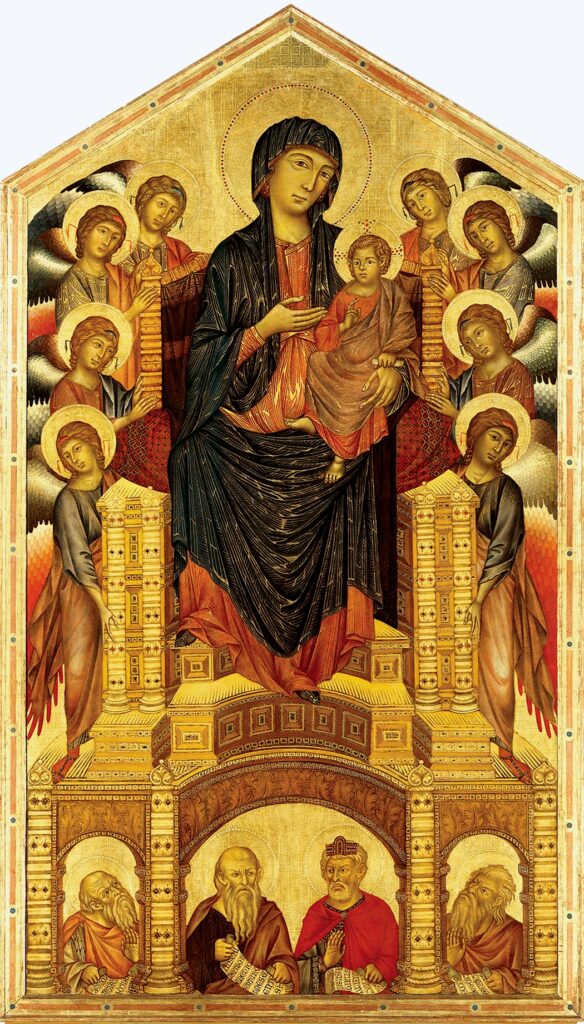
14. Cimabue, Maesta Enthroned
Located right next to Giotto’s Maesta in the Uffizi, Cimabue’s Madonna Enthroned is one of the most famous medieval paintings in Italy. It’s a large altarpiece painting created in the late 13th century. It’s also known as the Maestà di Santa Trinita.
This medieval painting in Italy is regarded as a masterpiece of the Italo-Byzantine style. The painting is dominated by a majestic representation of the Virgin Mary seated on a throne holding the infant Jesus in her lap.
They are surrounded by four angels in halos. Beneath them are six additional scenes from the life of Christ and the Virgin Mary.
Cimabue’s use of gold leaf and bright colors, particularly in the robes of the figures, adds to the splendor of the work. The painting’s intricate details, including the richly decorated background and the delicately painted faces of the figures, demonstrate Cimabue’s exceptional skills as an artist.
The Maesta was originally created for the high altar of the Church of Santa Trinita in Florence. In the 16th century, it was transferred to the Uffizi Gallery, where it is still on display today. The painting underwent an extensive restoration in the 20th century to remove dirt and overpainting, revealing the painting’s original colors and details.
Where: Florence, Uffizi Gallery
15. Triumph of Death, Pisa
The Triumph of Death is a series of frescos executed in the 1330s that can be found in the Camposanto Monumentale in Pisa. The frescos, which cover three walls, are known for their graphic depiction of death and decay. The work is attributed to either Buonamico Buffalmacco or Francesco Traini.
The frescos depict a range of scenes related to death and the afterlife. One section shows a group of people being slaughtered by an army of skeletons, while another depicts people being buried alive.
There are also scenes of people being eaten by animals and birds, as well as scenes of torture and execution. These gruesome images were intended to remind viewers of the inevitability of death and the importance of leading a virtuous life.
Despite the grisly subject matter, the frescos are highly regarded for their artistic merit. The figures are highly detailed, with a strong sense of movement and emotion. The use of light and shadow creates a sense of depth and drama, and the composition is carefully balanced to create a sense of harmony.
Where: Pisa, Camposanto on the Field of Miracles
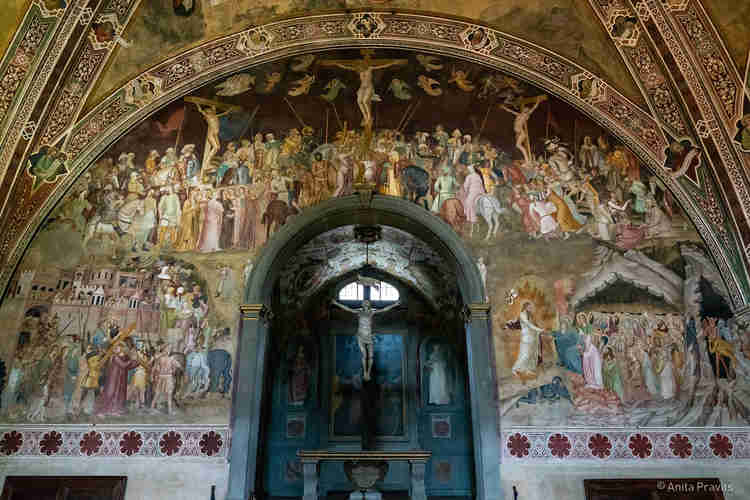
16. Bonaiuto, Spanish Chapel
The Spanish Chapel in Florence’s Santa Maria Novella has a 14th century masterpiece by Andrea di Bonaiuto. The medieval artist was so popular that he was also known as Andrea da Firenze.
His frescos, though rather threatening, are beautifully rendered and feature a bright jewel color scheme. Some scholars consider this style emblematic of the post-Black Death era, as it often depicted violence and had a pessimistic viewpoint.
The frescos showcase the life, death, passion, and resurrection of Christ. The overall theme is salvation through Christ, with the help and knowledge of the Dominicans. Black and white clad Dominican preachers lead mankind away from evil towards St. Peter and the pearly gates of heaven.
The largest painting in the chapel is the gory triple execution of Jesus in the center, surrounded by witnesses. The Resurrection and the famous Don’t Touch Me are painted on the ceiling, while the triangular vault space above the door shows the Ascension of Jesus.
Black and white dogs are often seen at the bottom of certain scenes. It’s a visual pun on the Dominicans, who were fearsome defenders of Catholicism and became dreaded inquisitors during the witch hunts of medieval Europe.
Where: Florence, Spanish Chapel Santa Maria Novella
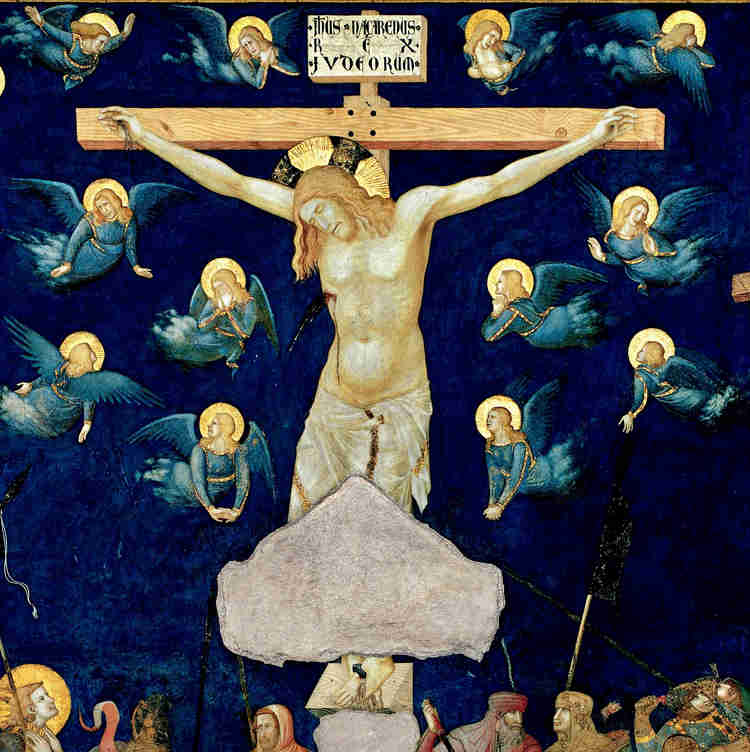
17. Cimabue, Crucifixion
The transept and apse of the upper church in the Basilica of St. Francis of Assisi contain a series of frescoes by the famed Cimabue. The frescoes in Assisi have a unique look. They appear like photographic negatives due to the artist’s use of lead-based paint which oxidized over time.
One of the most captivating paintings is the Crucifixion, located in the left transept. The figures are portrayed with expressive faces and dramatic gestures, drawing the viewer’s attention to the cross, which was considered the center of Franciscan thought.
The painting is a testament to Cimabue’s talent as an artist and his ability to convey deep emotion and spirituality through his work.
There is also a fresco series attributed to Giotto in the church. But many art historians, citing the quality and consistency of the frescoes, dispute this attribuition. However, they are a significant example of medieval Italian art.
Where: Assisi, Basilica of St. Francis of Assisi
18. Pierro della Francesca, Madonna del Parto
Piero della Francesca’s Madonna del Parto is the world’s most famous portrait of a pregnant Virgin. It can be found in a retrofitted schoolhouse that was transformed into a pilgrimage site for pregnant women.
The painting is displayed behind glass in a room flanked by three interpretive displays. According to legend, Piero painted the Madonna del Parto in just seven days and used his mother as the model for the Virgin with a swollen belly.
The painting itself is a 9 x 7 feet naturalistic fresco that depicts a pale and uncomfortable looking pregnant woman with a distended abdomen. The image makes you think that the Virgin has been summoned for a performance that she would rather skip.
Mary stands in a 3/4 pose with her hands on the back and heaving belly of her gown. The fresco is a sincere, all-too-human image.
Mary appears as an actual person, rather than an unassailable matriarch. There’s an almost imperceptible melancholy to the painting, perhaps indicative of the fear that often accompanies childbirth.
Where: Civic Museum, Monterchi
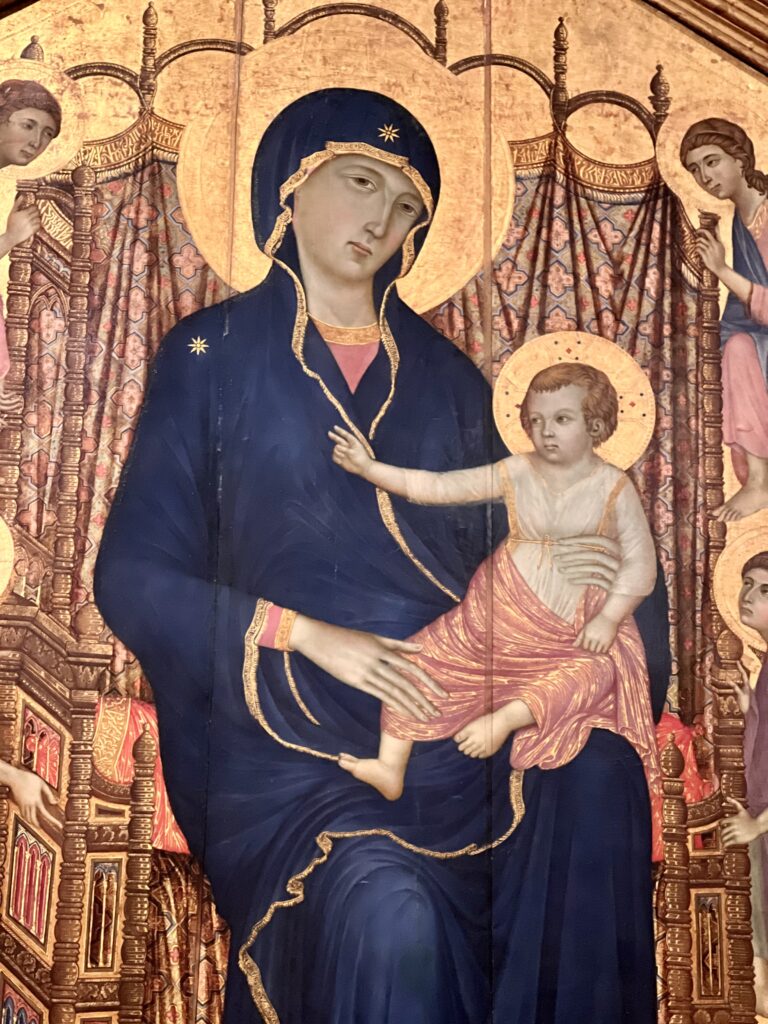
19. Duccio, Rucellai Madonna
Duccio’s Rucellai Madonna is a stunning painting housed in the Uffizi Gallery in Florence. It’s one of the earliest representations of the Madonna and Child in the Italian Renaissance.
In the painting, the pair are depicted sitting on a throne with a rich gold background, typical of Medieval art in Italy.
One of the most notable features of the painting is the intricate detailing of the Madonna’s robe. It’s decorated with elaborate gold patterns that are incredibly intricate and delicate.
The painting was commissioned by the wealthy Rucellai family of Florence, who were prominent patrons of the arts. The Rucellai family were supporters of the Dominican order, and the painting was in their private chapel in Santa Maria Novella until the 16th century.
Where: Florence, Uffizi Gallery
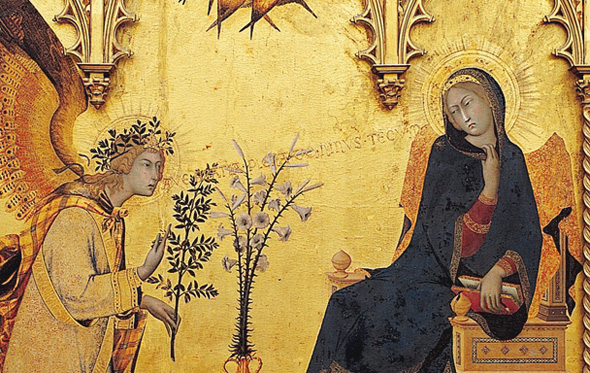
20. Simone Martini, Annunciation
Simone Martini was of the most talented medieval painters in Siena after Duccio. His Annunciation painting is celebrated for its elegance and vibrant color palette. The painting is divided into two sections, with the angel appearing on the left and the Virgin on the right.
The angel, dressed in a flowing robe, is portrayed with large wings and a halo around his head. He kneels before the Virgin holding a lily, which symbolizes purity. The Virgin, seated on a throne, is depicted wearing a crown and holding a book.
What makes this painting stand out is Martini’s masterful use of color. The deep blues and radiant golds of the Virgin’s robes are especially vivid. And the angel’s wings are a blend of colors, including green, blue, and purple.
Furthermore, Martini pays great attention to detail in the painting, including intricate floral designs and patterns on the angel’s robe. These intricate details add depth and complexity to the painting, making it a true masterpiece.
Where: Uffizi Gallery Florence
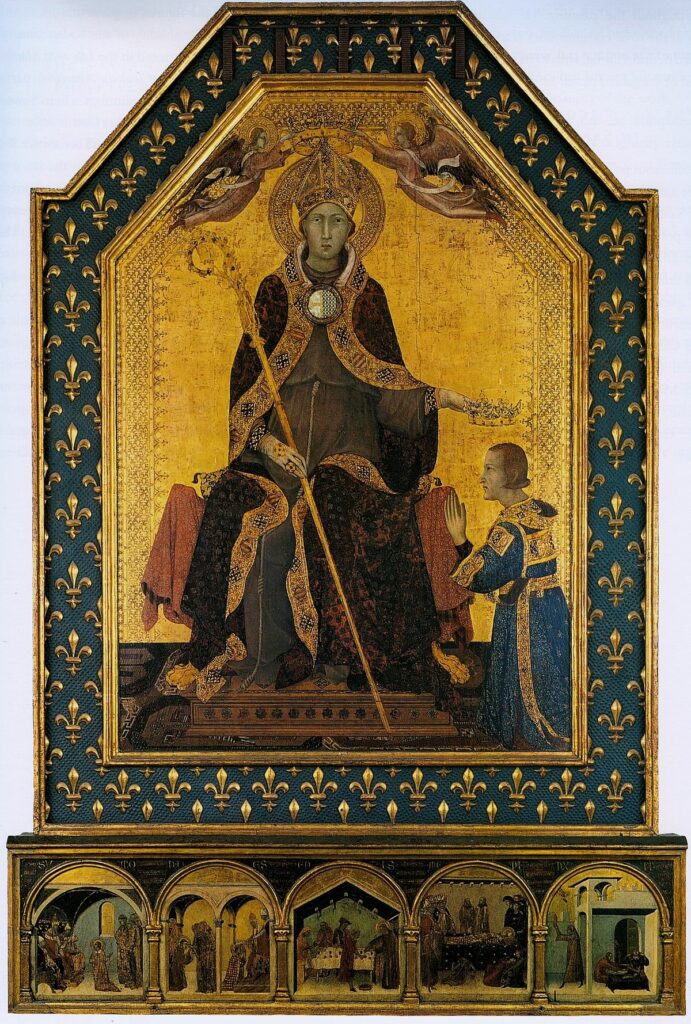
21. Simone Martini, Toulouse Altarpiece
This magnificent medieval painting in Italy was created by Simone Martini, who did not produce many surviving works. Housed in Naple’s Capodimonte Museum, it’s in perfect condition and has been authenticated.
The altarpiece stands at an impressive 10 feet in height and depicts St. Louis of Toulouse against a shimmering gold background. The painting features a double coronation, with Saint Louis being crowned by angels while simultaneously crowning his brother Robert the Wise of Anjou.
The depiction of St. Louis is particularly striking, as he is shown as a giant heraldic figure. In contrast, his brother is painted on a diminutive scale, wearing coronation robes and deferring to the saint.
The painting’s lower section is a predella, which showcases scenes from the saint’s life, including a posthumous miracle where he resurrects a stillborn infant.
Where: Naples, Capodimonte Museum
I hope you’ve enjoyed my guide to the most famous medieval paintings in Italy. You may enjoy these other Italy travel guides and resources:
- 3 day itinerary for Rome
- 5 day itinerary for Rome
- 1 day itinerary for Vatican City
- 3 day itinerary for Florence
- 2 day itinerary for Venice
- 1 day itinerary for Milan
- 1 day itinerary for Siena
- One week in Umbria
- 10 days in Italy itinerary
- 10 day itinerary for Tuscany
- 12 ways to spend 1 week in Italy
- 2 weeks in Sicily itinerary
If you’d like to see Italy’s medieval masterpieces, pin it for later.

